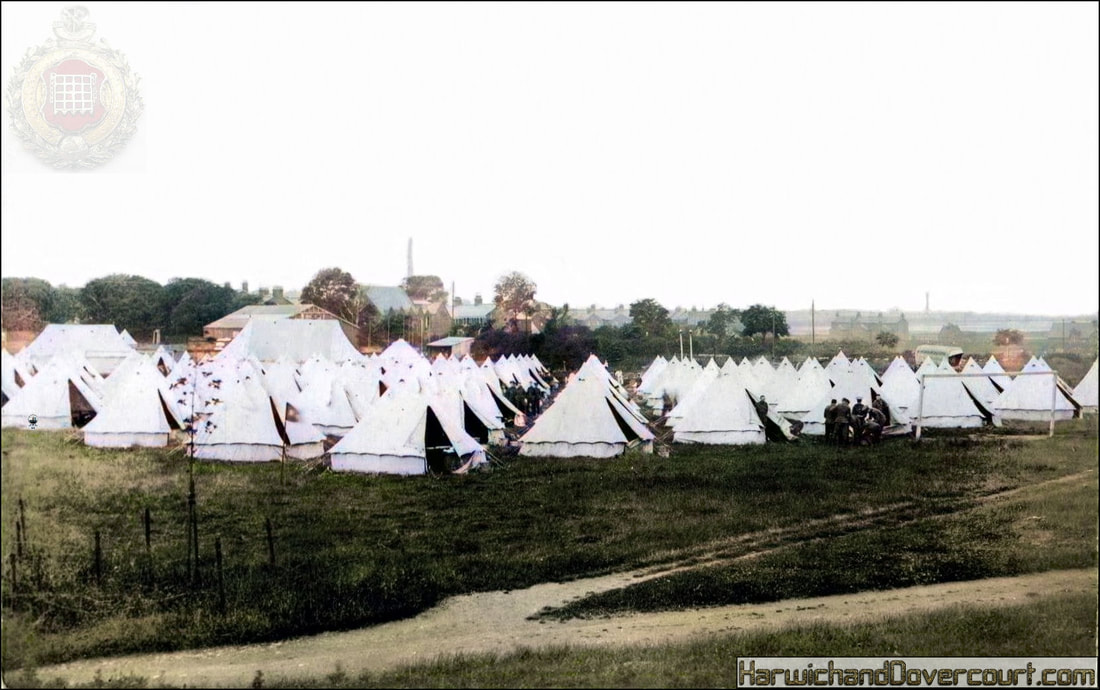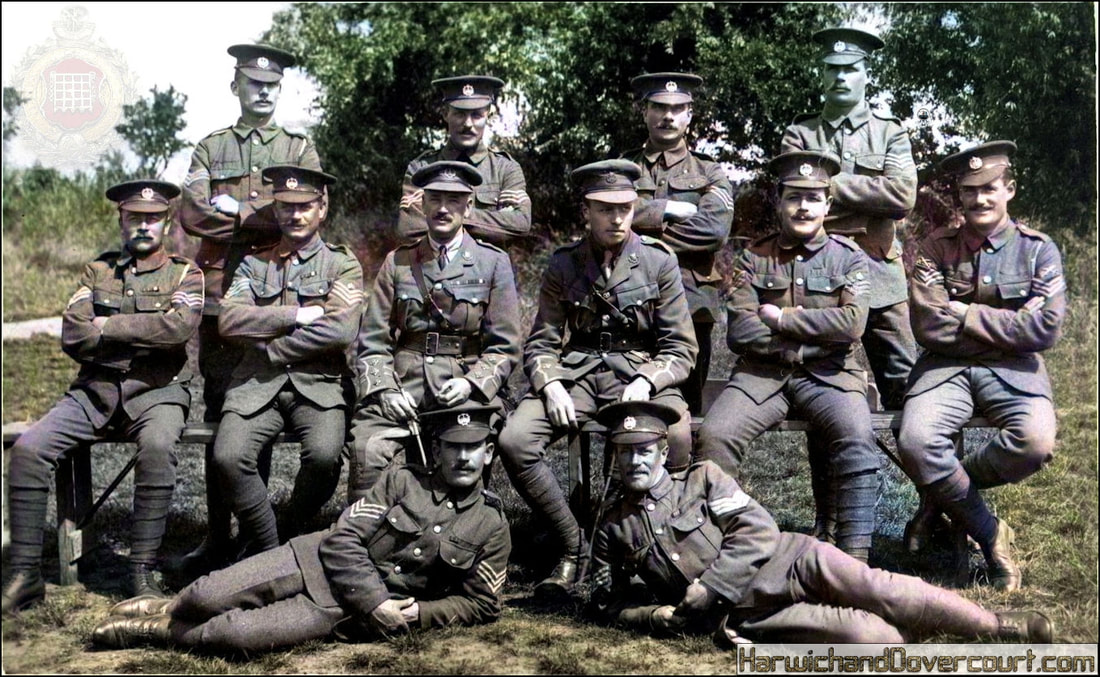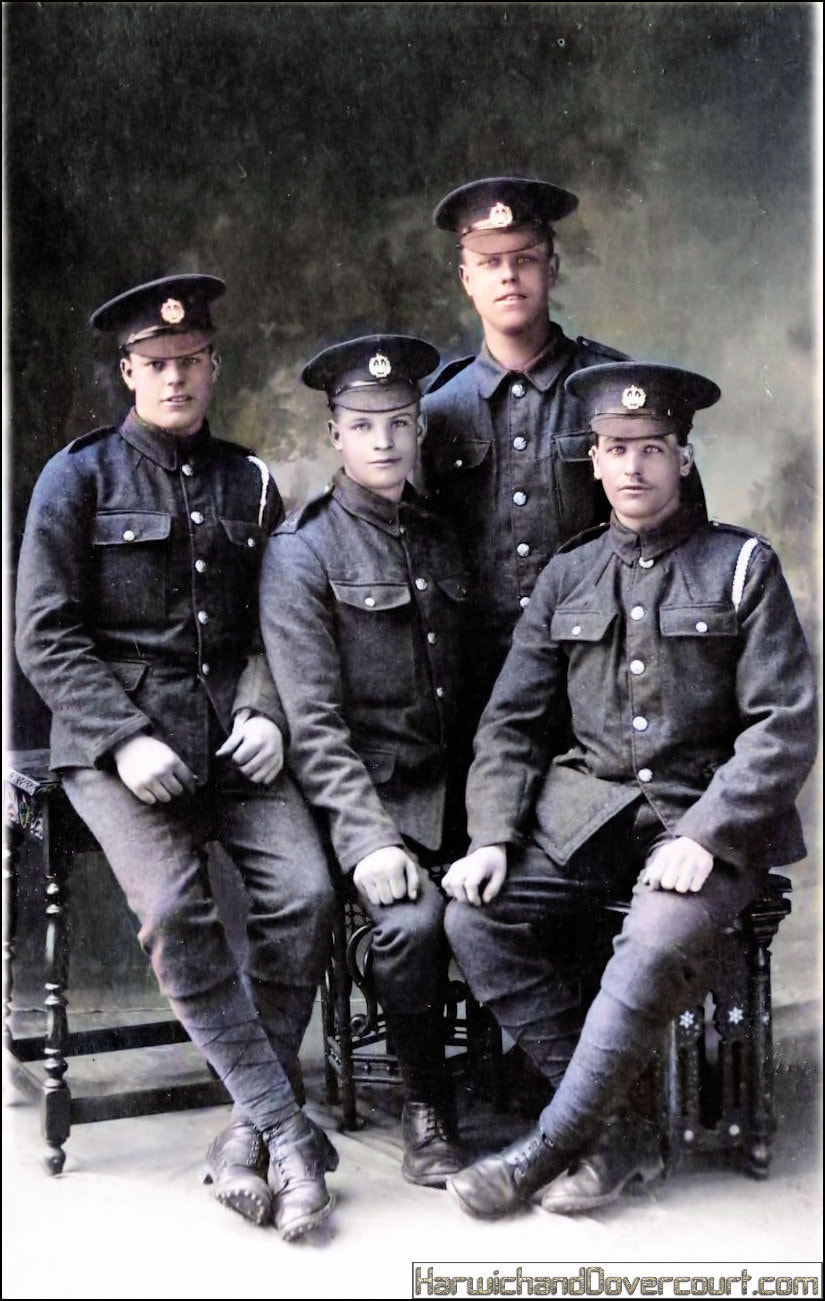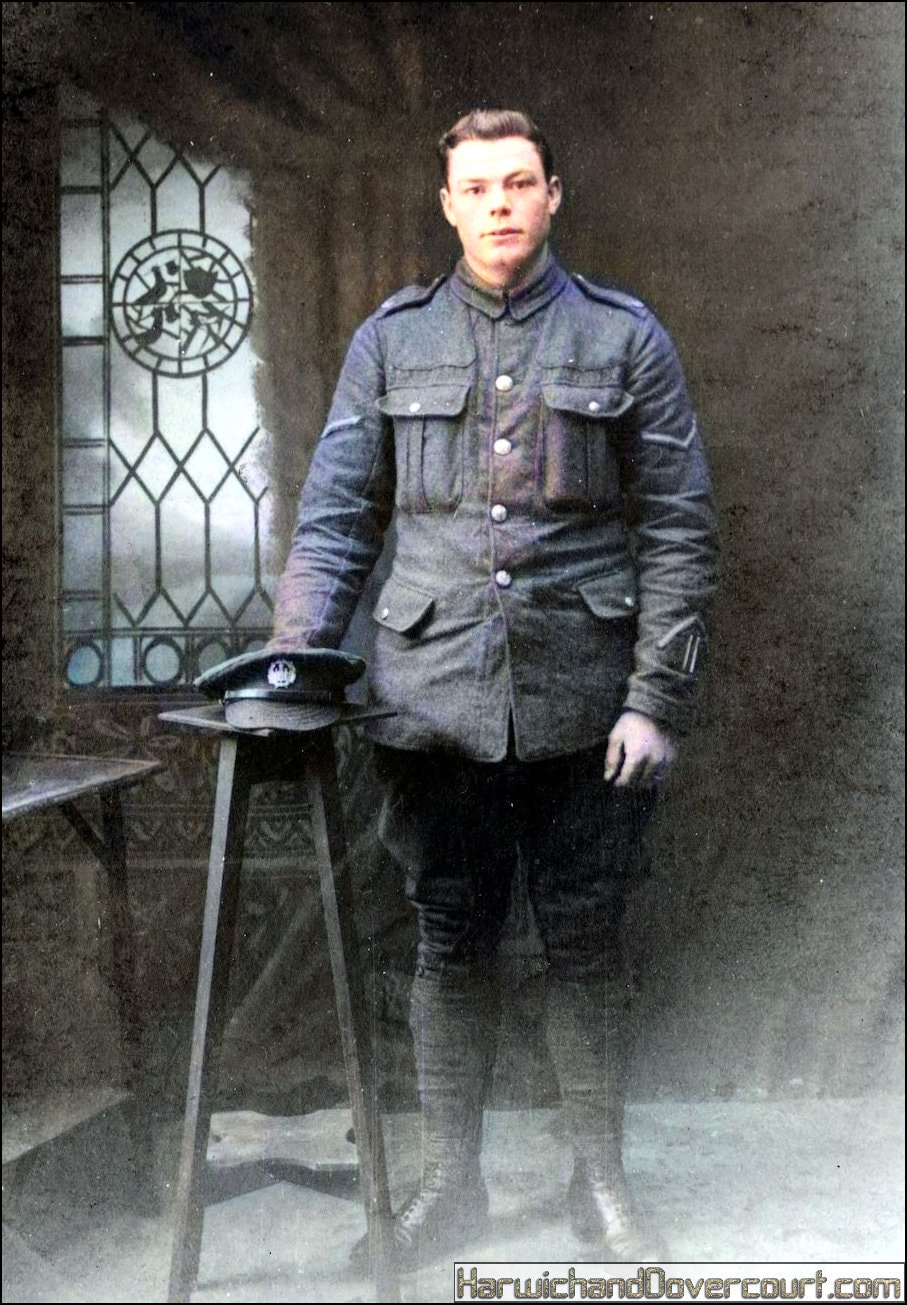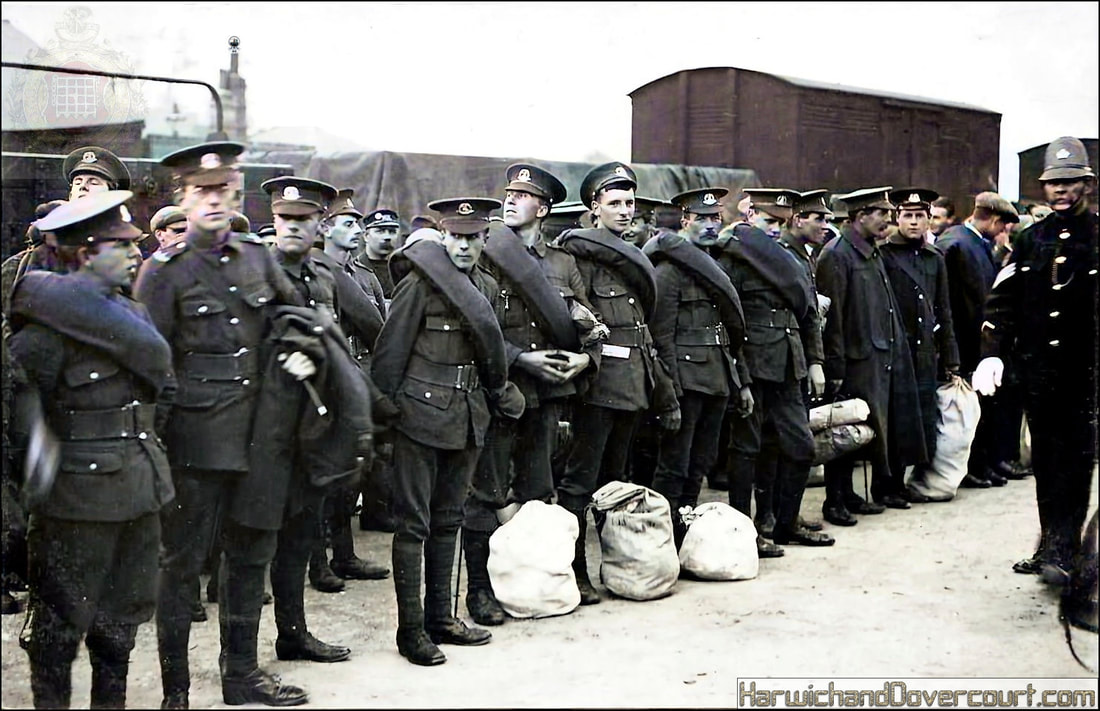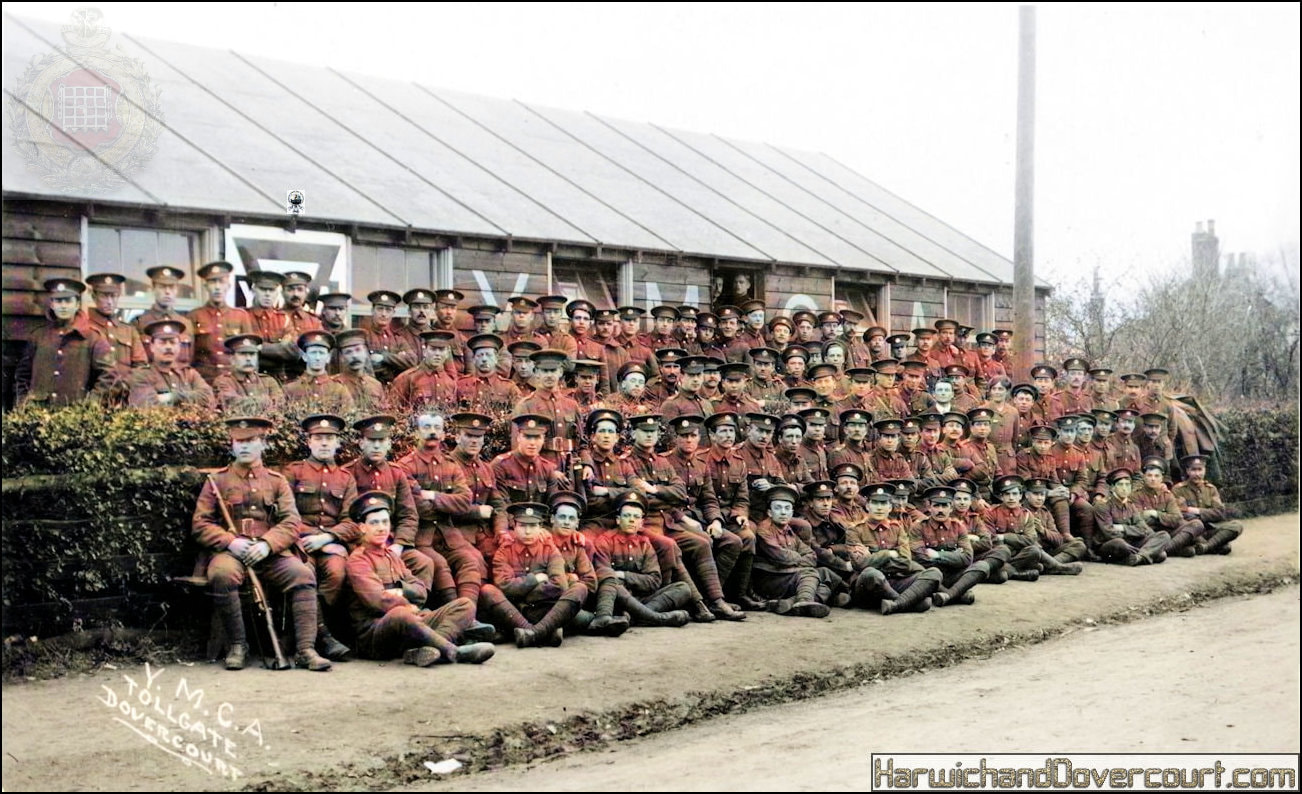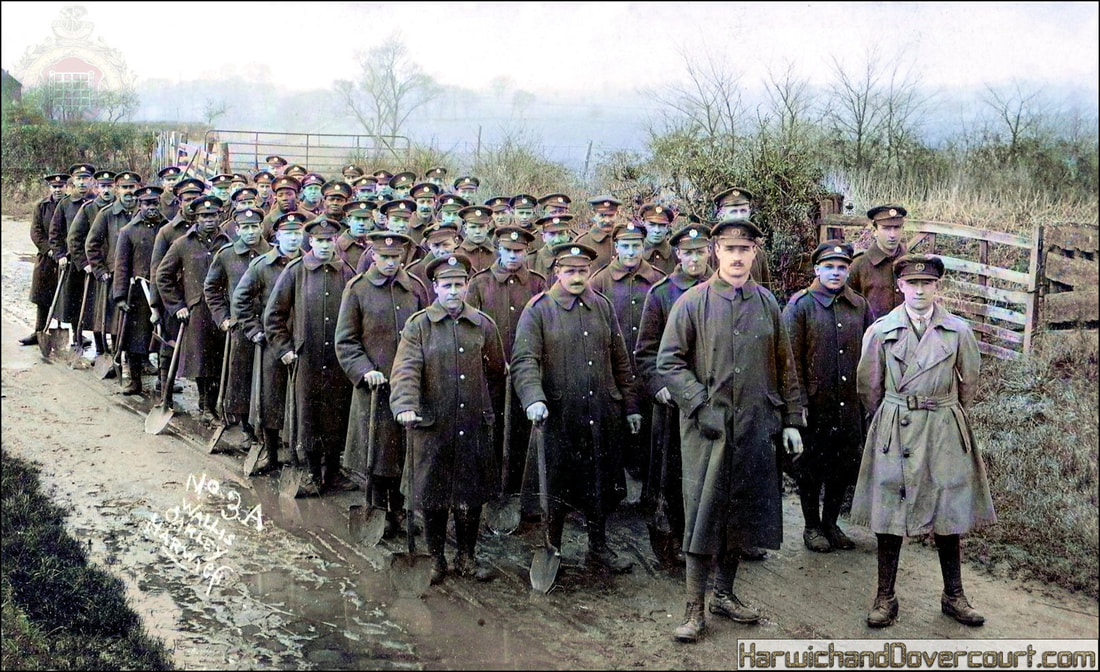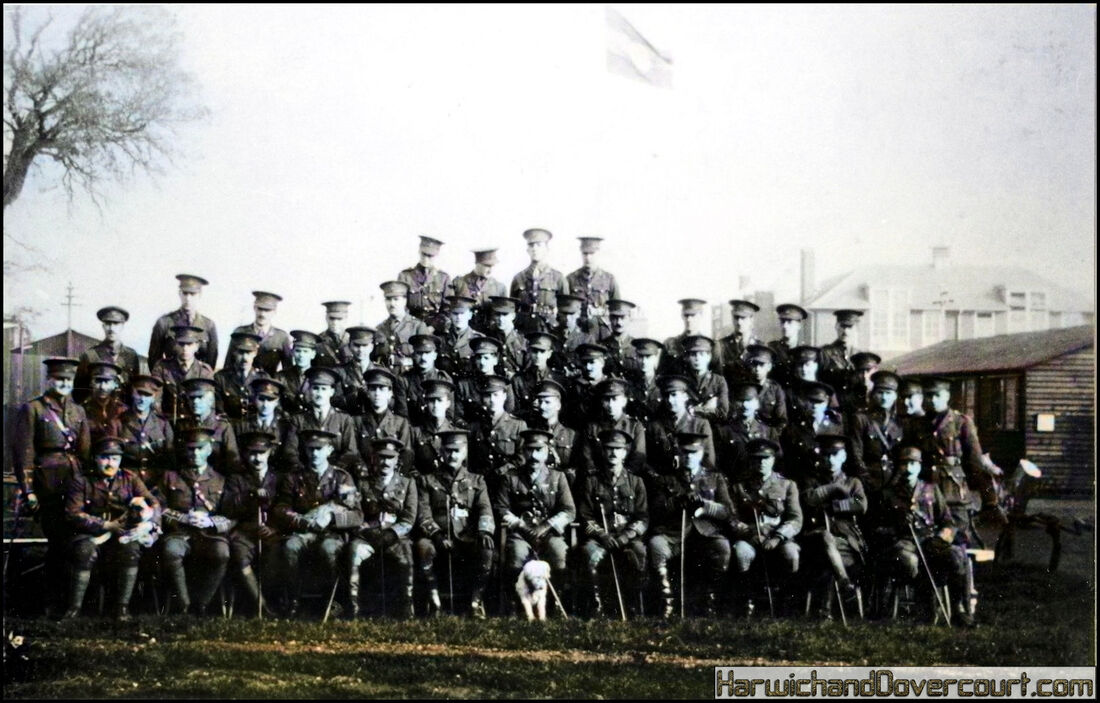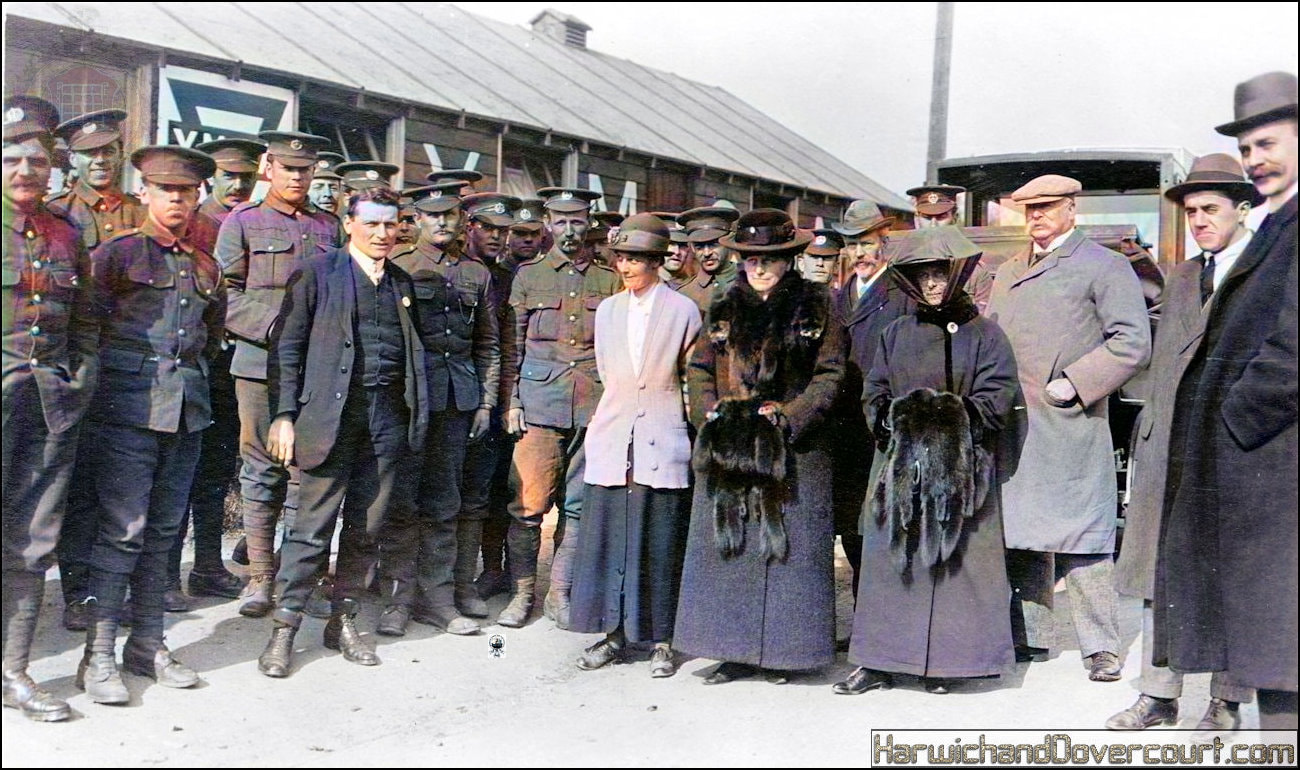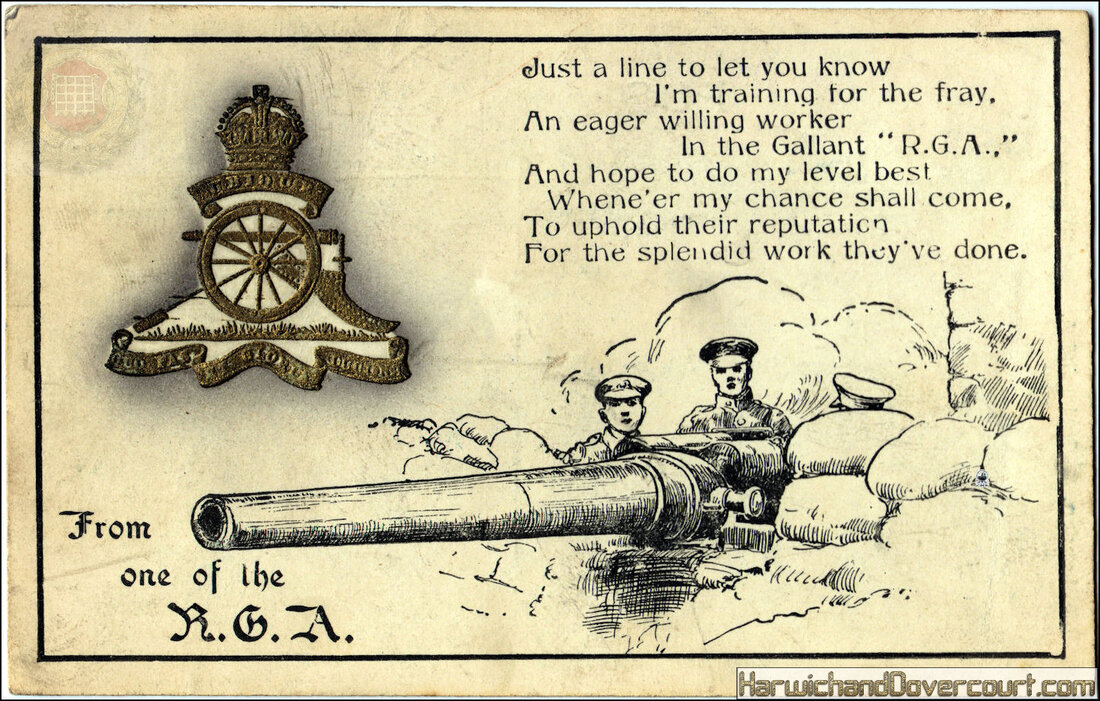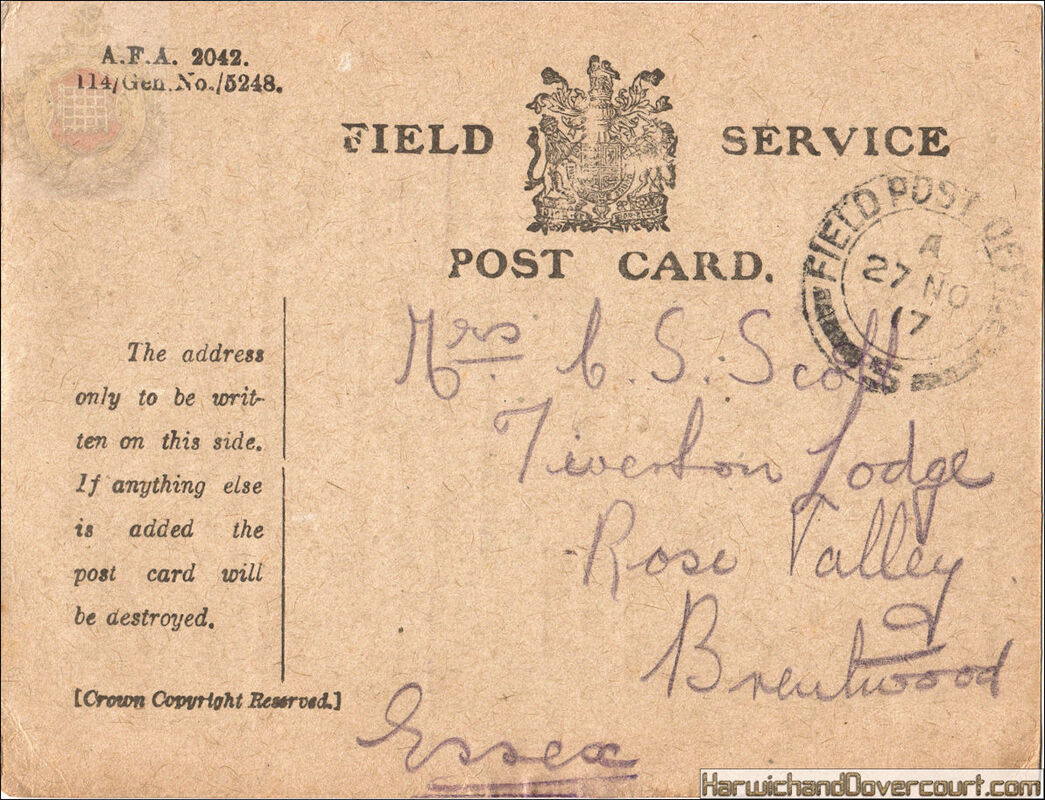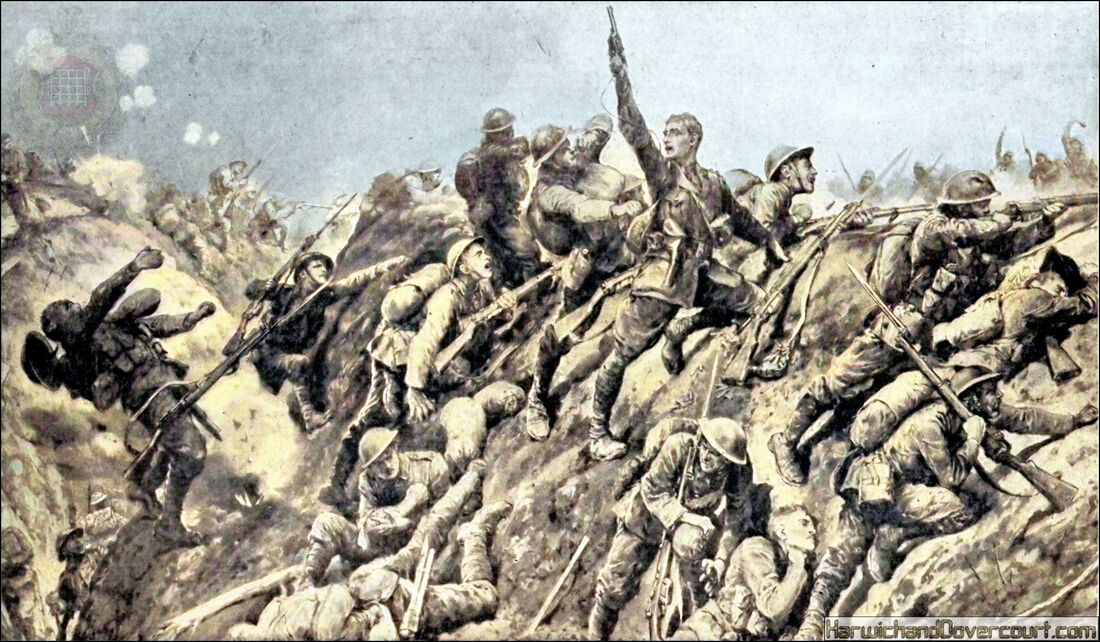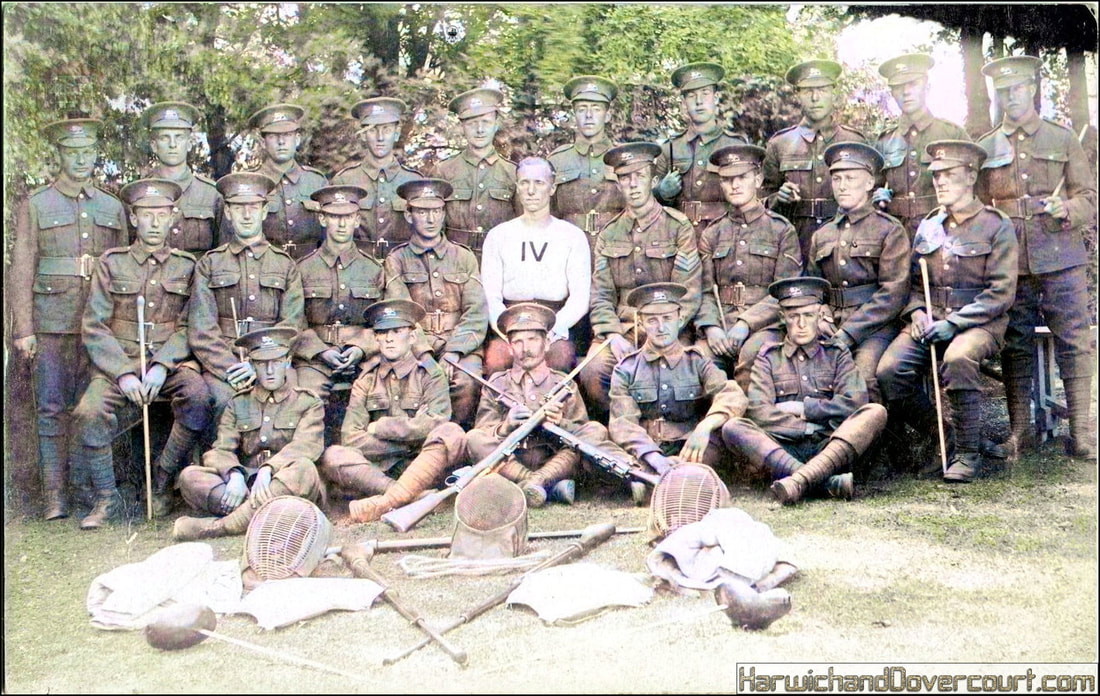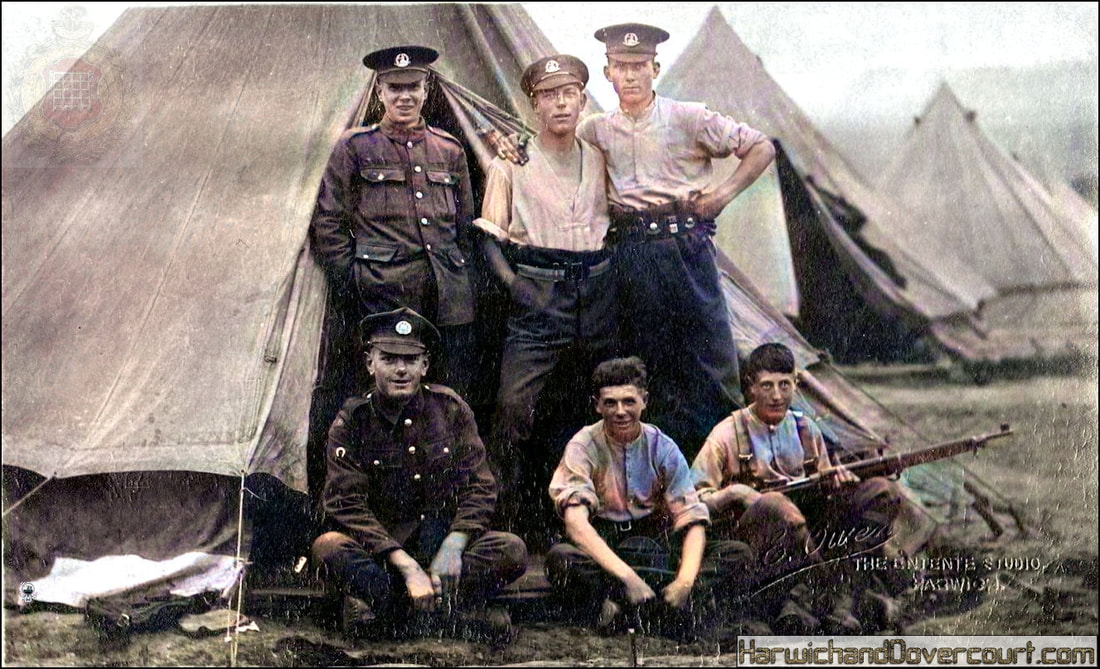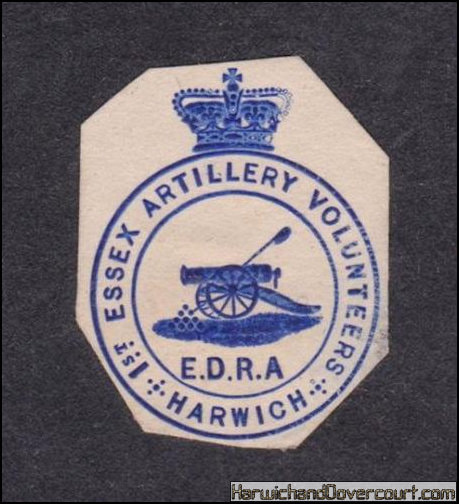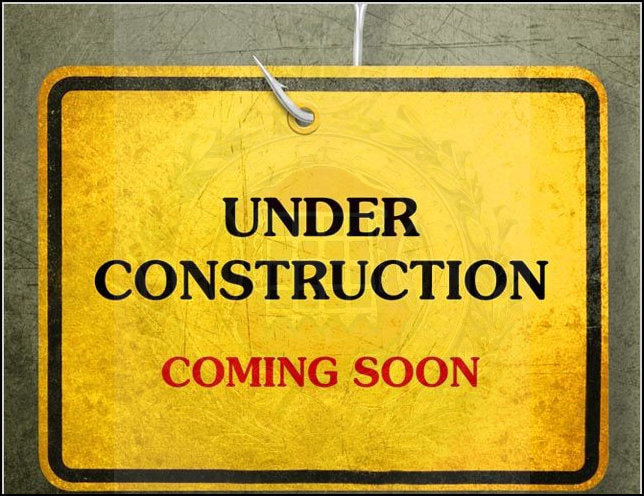~ Brother's In Arms ~
Although the Harwich peninsula was dominated in WW1 by both shipping & submarines, the land forces of the Army were in place, with many different regiments billeted and encamped in the local area.
Obviously Essex, Suffolk & Norfolk battalions were common place, but many other regiments were also seen in the town.
Men of the Royal Garrison Artillery manned the fortifications, with a local Head Quarters close to Beacon Hill Fort.
Obviously Essex, Suffolk & Norfolk battalions were common place, but many other regiments were also seen in the town.
Men of the Royal Garrison Artillery manned the fortifications, with a local Head Quarters close to Beacon Hill Fort.
1915 ~ An Army Camp, Dovercourt (No location given due to Army Censor) H&D FW
1915 ~ Essex Officers (Captain and 2nd Lieutenant) alongside N.C.O's (R.G.A.) at Harwich.
Photo by Wallis H&D
1915 ~ The Norfolk's on Military Guard at Camp, Oakley, Essex
~ Troops were trained and then shipped from Harwich, to the Western Front) H&D ~
1915 ~ A London Underground official Letter
~ (Postage Dues, were still being collected) to the R.G.A. at Beacon Hill, Harwich H&D ~
~ 1915 ~ Royal Garrison Artillery at Dovercourt, Essex (Beacon Hill Fort) by Steggles H&D ~
Essex & Suffolk Servicemen
1915 ~ Private Walter Newman (left seated) with three other young faces from the 13th Essex Regiment, known as the "West Ham Pals" battalion, photographed at Felixstowe, Suffolk, prior to being shipped out to the Western Front from Harwich. |
1916 ~ Private Walter Newman (now with a battle wound stripe on his left sleeve) from the 13th Essex Regiment. Photographed again at Felixstowe, Suffolk, prior to treatment at the Harwich Military Hospital, before returning to France again. |
1916 ~ Another local hero from WW1 Sergeant George R Felgate, of the Royal Garrison Artillery (Dovercourt). Photographed again at Felixstowe, Suffolk in 1916 (same background as Walter).
|
1917 ~ Lance Corporal Walter Newman (now with two battle wound stripes on his left sleeve and a "good conduct" stripe) from the 13th Essex Regiment,
|
Walter was badly injured and captured in the battalion’s epic “Last Stand” at the Battle of Cambrai on the 30th November 1917, however his luck didn't run out and he survived the war, with his Daughter Molly Bleakley, still living locally in the town.
~ 1915 ~ The Norfolk’s, shipping out of Harwich, Essex (possibly en-route to Gallipoli) H&D ~
1916 ~ M260 YMCA Dovercourt (M) Wallis H&D ~
At the newly built Y.M.C.A. at Tollgate, Upper Dovercourt.
~ 1916 ~ Military Camp. Harwich (Censored) Steggles of Harwich H&D ~
~ 1916 ~ No 3A ~ The Essex Regiment at Oakley, Near Harwich (Trench Training) Wallis H&D ~
1916 ~ Officer's from the "Essex" Regiment, taken at Hill School, (Mayflower) Dovercourt Bay, Essex
1916 ~ Opening of the YMCA. at Dovercourt, Essex (Tollgate, Upper Dovercourt) H&D
1916 ~ Postcard form the R.G.A. Training, at Beacon Hill Fort, Harwich ~
~ (Censored) B.B. London H&D ~
1916 ~13th Company R.G.A. Football Team, Harwich (Beacon Hill Fort) H&D ~
1917 ~ 13th Essex Field Post (Front) H&D FW (1)
1917 ~ 13th Essex Field Post (Back) H&D FW (2)
1917 ~ “Last Stand” at the Battle of Cambrai
The 13th Essex Men at Moeuvres ~ “Up The Hammers!”
The story of the West Ham Battalion during World War One is one that is well-known to supporters of West Ham United Football Club. In December 1914 the Mayor of West Ham successfully applied to the War Office to raise an infantry unit of local men to serve in the British Army, who had by then already suffered heavy losses on the Western Front. Formed as the 13th (Service) Battalion of the Essex Regiment, the West Ham Pals were born.
Volunteers, many of them West Ham United‘s first generation of supporters, flooded the recruiting offices around the East End and by late February the required 1,000 men had enlisted. They had no uniforms, no rifles and many had no military experience. However, they all wanted to “give a good smacking to the Germans”.
The Council soon applied for their cap badge to include two crossed hammers, in reference to their association with the Thames Ironworks and Shipbuilding Company, however this was refused. Nonetheless, the retained strong links with West Ham and the battle cry “Up The Hammers!” was used throughout the war.
The battalion trained locally before progressing to Advanced Infantry Training on Salisbury Plain. Tragically, three of the volunteers were to be killed during this training, however, this did not deter their eagerness to meet the Germans on the field of battle.
After landing in France in December 1915, they would go on to fight the whole war alongside the 17th (Service) Battalion of the Middlesex Regiment, better known as the Footballers’ Battalion. Meanwhile, back in United Kingdom, the Reserve Companies of the played at the Boleyn Ground in an effort to encourage more local men to enlist.
The West Ham Battalion acquitted themselves very well on the battlefield and fought actions during the Battle of the Somme, at Vimy Ridge and Cambrai. Many Officers were awarded the Military Cross (one twice!) while many men from the ranks won the Military Medal and Distinguished Conduct Medal (second only to the Victoria Cross).
Their battalion’s epic “Last Stand” at the Battle of Cambrai, as shown here made the front pages of many newspapers in late 1917. By the end of World War One, out of the original 1,000 men, roughly one quarter were killed, half were severely disabled from wounds and one quarter survived with their scars inside. They never received a Victory Parade and sadly the West Ham Battalion was quickly forgotten and relegated to history.
“Up The Hammers!”
If you want to find out more read the excellent book by Elliott Taylor author of
"Up The Hammers! : The West Ham Battalion in the Great War 1914-1918"
Volunteers, many of them West Ham United‘s first generation of supporters, flooded the recruiting offices around the East End and by late February the required 1,000 men had enlisted. They had no uniforms, no rifles and many had no military experience. However, they all wanted to “give a good smacking to the Germans”.
The Council soon applied for their cap badge to include two crossed hammers, in reference to their association with the Thames Ironworks and Shipbuilding Company, however this was refused. Nonetheless, the retained strong links with West Ham and the battle cry “Up The Hammers!” was used throughout the war.
The battalion trained locally before progressing to Advanced Infantry Training on Salisbury Plain. Tragically, three of the volunteers were to be killed during this training, however, this did not deter their eagerness to meet the Germans on the field of battle.
After landing in France in December 1915, they would go on to fight the whole war alongside the 17th (Service) Battalion of the Middlesex Regiment, better known as the Footballers’ Battalion. Meanwhile, back in United Kingdom, the Reserve Companies of the played at the Boleyn Ground in an effort to encourage more local men to enlist.
The West Ham Battalion acquitted themselves very well on the battlefield and fought actions during the Battle of the Somme, at Vimy Ridge and Cambrai. Many Officers were awarded the Military Cross (one twice!) while many men from the ranks won the Military Medal and Distinguished Conduct Medal (second only to the Victoria Cross).
Their battalion’s epic “Last Stand” at the Battle of Cambrai, as shown here made the front pages of many newspapers in late 1917. By the end of World War One, out of the original 1,000 men, roughly one quarter were killed, half were severely disabled from wounds and one quarter survived with their scars inside. They never received a Victory Parade and sadly the West Ham Battalion was quickly forgotten and relegated to history.
“Up The Hammers!”
If you want to find out more read the excellent book by Elliott Taylor author of
"Up The Hammers! : The West Ham Battalion in the Great War 1914-1918"
1917 ~ Reserves Army Camp, Harwich H&D FW ~ The Entente Studio, Harwich Photograph.
~ 1917 ~ Hut 7 RGA Beacon Hill Fort, Harwich ~
~ prior to going out onto the Western Front ~ H&D
1917 ~ King’s Own Royal Lancaster Regiment, 3rd Battalion at Beacon Hill Fort, Harwich H&D ~ Still time for some fencing ~
1917 ~ "Norfolk" Reserves Army Camp, Harwich H&D FW ~ The Entente Studio, Harwich Photograph.
The Norfolk's, Camped out at Dovercourt in WW1 (E.Owen, The Entente Studio, Harwich)
108th Anniversary of World War One , when Harwich and the surrounding area was bustling with both Army and Navel forces. Harwich had one of the largest submarine basis. The Town Hall at Harwich served a Military Hospital in WW1. The Harwich Force was a squadron of the Royal Navy, formed during the First World War and based in Harwich. It played a significant role in the war. In 1918 the Surrender of the German Fleet Under the terms of the Armistice, all U-boats were to immediately surrender.
Those in home waters sailed to the British submarine base at Harwich.
108th Anniversary of World War One , when Harwich and the surrounding area was bustling with both Army and Navel forces. Harwich had one of the largest submarine basis. The Town Hall at Harwich served a Military Hospital in WW1. The Harwich Force was a squadron of the Royal Navy, formed during the First World War and based in Harwich. It played a significant role in the war. In 1918 the Surrender of the German Fleet Under the terms of the Armistice, all U-boats were to immediately surrender.
Those in home waters sailed to the British submarine base at Harwich.
